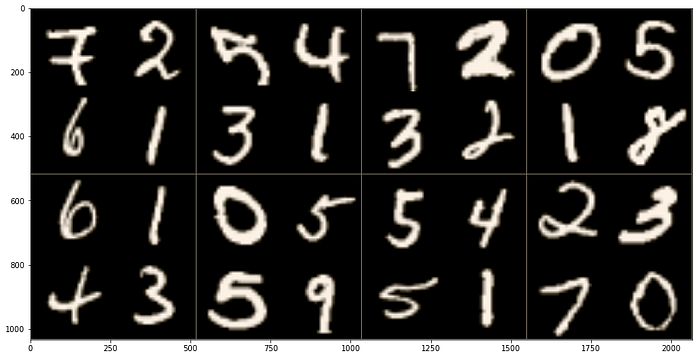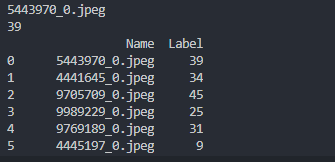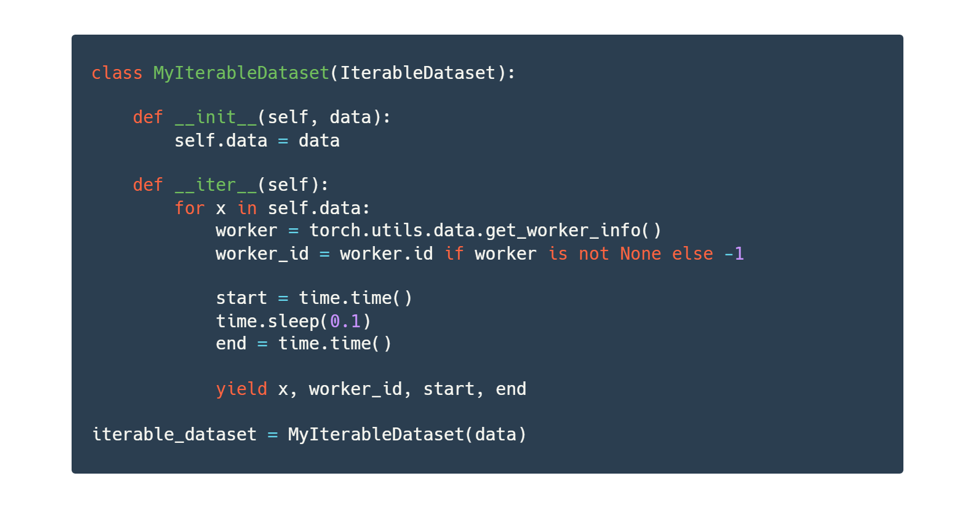44 pytorch dataloader without labels
Custom Dataloader in pytorch - Data Science Stack Exchange I am working on an image classification project where I have some images in a folder and their corresponding labels in a CSV file. The indices are randomly arranged in the dataframe where the index maps to the list of indices of images in the directory. PyTorch: Train without dataloader (loop trough dataframe instead) Create price matrix from tidy data without for loop. 20. Loading own train data and labels in dataloader using pytorch? 0. Can pytorch / keras support dataloader object of Image and Text? 3. Python: Fast indexing of strings in nested list without loop. 1. pytorch __init__() got an unexpected keyword argument 'train' 0.
anndata DataLoader for pyTorch without DistributedSampler #757 When I try to predict a cell type label using the predict function, pyTorch lightning wants to use the DistributedSampler as sampler, which is not implemented in the AnnLoader and I could not figure out how to disable the sampler. Here's my code: import gdown import pytorch_lightning as pl import torch import torch.nn as nn import numpy as np

Pytorch dataloader without labels
Loading data in PyTorch — PyTorch Tutorials 1.12.0+cu102 documentation The DataLoader combines the dataset and a sampler, returning an iterable over the dataset. data_loader = torch.utils.data.DataLoader(yesno_data, batch_size=1, shuffle=True) 4. Iterate over the data. Our data is now iterable using the data_loader. This will be necessary when we begin training our model! Load Pandas Dataframe using Dataset and DataLoader in PyTorch. Then, the file output is separated into features and labels accordingly. Finally, we convert our dataset into torch tensors. Create DataLoader. To train a deep learning model, we need to create a DataLoader from the dataset. DataLoaders offer multi-worker, multi-processing capabilities without requiring us to right codes for that. How to load Images without using 'ImageFolder' - PyTorch Forums The DataLoader is not responsible for the data and target creation, but allows you to automatically create batches, use multiprocessing to load the data in the background, use custom samplers, shuffle the dataset etc. The Dataset defines how the data and target samples are created.
Pytorch dataloader without labels. Unsupervised Data set reading - vision - PyTorch Forums In particular, the __getitiem__ method, which returns a tuple comprising (data, label) The generic loop is something like: for (data, labels) in dataloader: # train / eval code You're free to ignore the label here and you can train an autoencoder on cifar10, for example, pretty much out of the box. Iterating through DataLoader using iter() and next() in PyTorch Our DataLoader would process the data, and return 8 batches of 4 images each. The Dataset class is an abstract class representing the dataset. It allows us to treat the dataset as an object of a class, rather than a set of data and labels. Dataset class returns a pair of [input, label] every time it is called. PyTorch DataLoader Quick Start - Sparrow Computing PyTorch Dataset objects are very flexible — they can return any kind of tensor(s) you want. But supervised training datasets should usually return an input tensor and a label. For illustration purposes, let's create a dataset where the input tensor is a 3×3 matrix with the index along the diagonal. The label will be the index. Create a pyTorch testing Dataset (without labels) - Stack Overflow This works well for my training data, but I get an error ( KeyError: " ['label'] not found in axis") when loading the testing csv file, which is identical other than there being no "label" column. If it helps, the intended input csv file is MNIST data in csv file which has 28*28 feature columns.
Issue with DataLoader with lr_finder.range_test #71 - GitHub Because inputs_labels_from_batch() was designed to avoid users modifying their existing code of dataset/data loader. You can just implement your logic inside it. And just note that you have to make sure the returned value of inputs_labels_from_batch() have to be 2 array-like objects, just like the line 41 shows: Creating a custom Dataset and Dataloader in Pytorch - Medium A dataloader in simple terms is a function that iterates through all our available data and returns it in the form of batches. For example if we have a dataset of 100 images, and we decide to batch... How to use Datasets and DataLoader in PyTorch for custom text data TD = CustomTextDataset (text_labels_df ['Text'], text_labels_df ['Labels']): This initialises the class we made earlier with the 'Text' and 'Labels' data being passed in. This data will become 'self.text' and 'self.labels' within the class. The Dataset is saved under the variable named TD. The Dataset is now initialised and ready to be used! PyTorch Dataloader + Examples - Python Guides In this section, we will learn about How PyTorch dataloader can add dimensions in python. The dataloader in PyTorch seems to add some additional dimensions after the batch dimension. Code: In the following code, we will import the torch module from which we can add a dimension.
DataLoader returns labels that do not exist in the DataSet - PyTorch Forums When I pass this dataset to a DataLoader (with or without a sampler) it returns labels that are outside the label set, for example 112, 105 etc… I am very confused as to how this is happening as I tried to simplify things as much as possible and it still happens. Datasets & DataLoaders — PyTorch Tutorials 1.12.0+cu102 documentation PyTorch provides two data primitives: torch.utils.data.DataLoader and torch.utils.data.Dataset that allow you to use pre-loaded datasets as well as your own data. Dataset stores the samples and their corresponding labels, and DataLoader wraps an iterable around the Dataset to enable easy access to the samples. Multilabel Classification With PyTorch In 5 Minutes - Medium Our custom dataset and the dataloader work as intended. We get one dictionary per batch with the images and 3 target labels. With this we have the prerequisites for our multilabel classifier. Custom Multilabel Classifier (by the author) First, we load a pretrained ResNet34 and display the last 3 children elements. Loading own train data and labels in dataloader using pytorch? # create a dataset like the one you describe from sklearn.datasets import make_classification x,y = make_classification () # load necessary pytorch packages from torch.utils.data import dataloader, tensordataset from torch import tensor # create dataset from several tensors with matching first dimension # samples will be drawn from the first …
DataLoader without dataset replica · Issue #2052 · pytorch ... - GitHub - ah I'm sorry. I just realized that it might actually be getting pickled - in such case there are two options: 1. make the numpy array mmap a file <- the kernel will take care of everything for you and won't duplicate the pages 2. use a torch tensor inside your dataset and call .share_memory_() before you start iterating over the data loader
Creating a dataloader without target values - PyTorch Forums I am trying to create a dataloader that will return batches of input data that doesn't have target data. Here's what I am doing: torch_input = torch.from_numpy (x_train) torch_target = torch.from_numpy (y_train) ds_x = torch.utils.data.TensorDataset (torch_input) ds_y = torch.utils.data.TensorDataset (torch_target) train_loader = torch ...
[Pytorch]PyTorch Dataloader custom data reading (all pictures in one ... [Pytorch]PyTorch Dataloader custom data reading. Sort out the user-defined data reading methods you see. There are three better articles. In fact, the user-defined method is to return the train and test of the existing data set with the list containing image path and label respectively, so you need to adapt according to the data set.
Beginner's Guide to Loading Image Data with PyTorch Create a DataLoader The following steps are pretty standard: first we create a transformed_dataset using the vaporwaveDataset class, then we pass the dataset to the DataLoader function, along with a few other parameters (you can copy paste these) to get the train_dl. batch_size = 64 transformed_dataset = vaporwaveDataset (ims=X_train)
Data loader without labels? - PyTorch Forums Is there a way to the DataLoader machinery with unlabeled data? PyTorch Forums. Data loader without labels? cossio January 19, 2020, 6:03pm #1. Is there a way to the DataLoader machinery with unlabeled data? ptrblck January 20, 2020, 2:11am #2. Yes, DataLoader doesn ...
Writing Custom Datasets, DataLoaders and Transforms - PyTorch Writing Custom Datasets, DataLoaders and Transforms. A lot of effort in solving any machine learning problem goes into preparing the data. PyTorch provides many tools to make data loading easy and hopefully, to make your code more readable. In this tutorial, we will see how to load and preprocess/augment data from a non trivial dataset.
Image Data Loaders in PyTorch - PyImageSearch A DataLoader accepts a PyTorch dataset and outputs an iterable which enables easy access to data samples from the dataset. On Lines 68-70, we pass our training and validation datasets to the DataLoader class. A PyTorch DataLoader accepts a batch_size so that it can divide the dataset into chunks of samples.
Developing Custom PyTorch Dataloaders Now that you've learned how to create a custom dataloader with PyTorch, we recommend diving deeper into the docs and customizing your workflow even further. You can learn more in the torch.utils.data docs here. Total running time of the script: ( 0 minutes 0.000 seconds)
How to load Images without using 'ImageFolder' - PyTorch Forums The DataLoader is not responsible for the data and target creation, but allows you to automatically create batches, use multiprocessing to load the data in the background, use custom samplers, shuffle the dataset etc. The Dataset defines how the data and target samples are created.
Load Pandas Dataframe using Dataset and DataLoader in PyTorch. Then, the file output is separated into features and labels accordingly. Finally, we convert our dataset into torch tensors. Create DataLoader. To train a deep learning model, we need to create a DataLoader from the dataset. DataLoaders offer multi-worker, multi-processing capabilities without requiring us to right codes for that.









Post a Comment for "44 pytorch dataloader without labels"